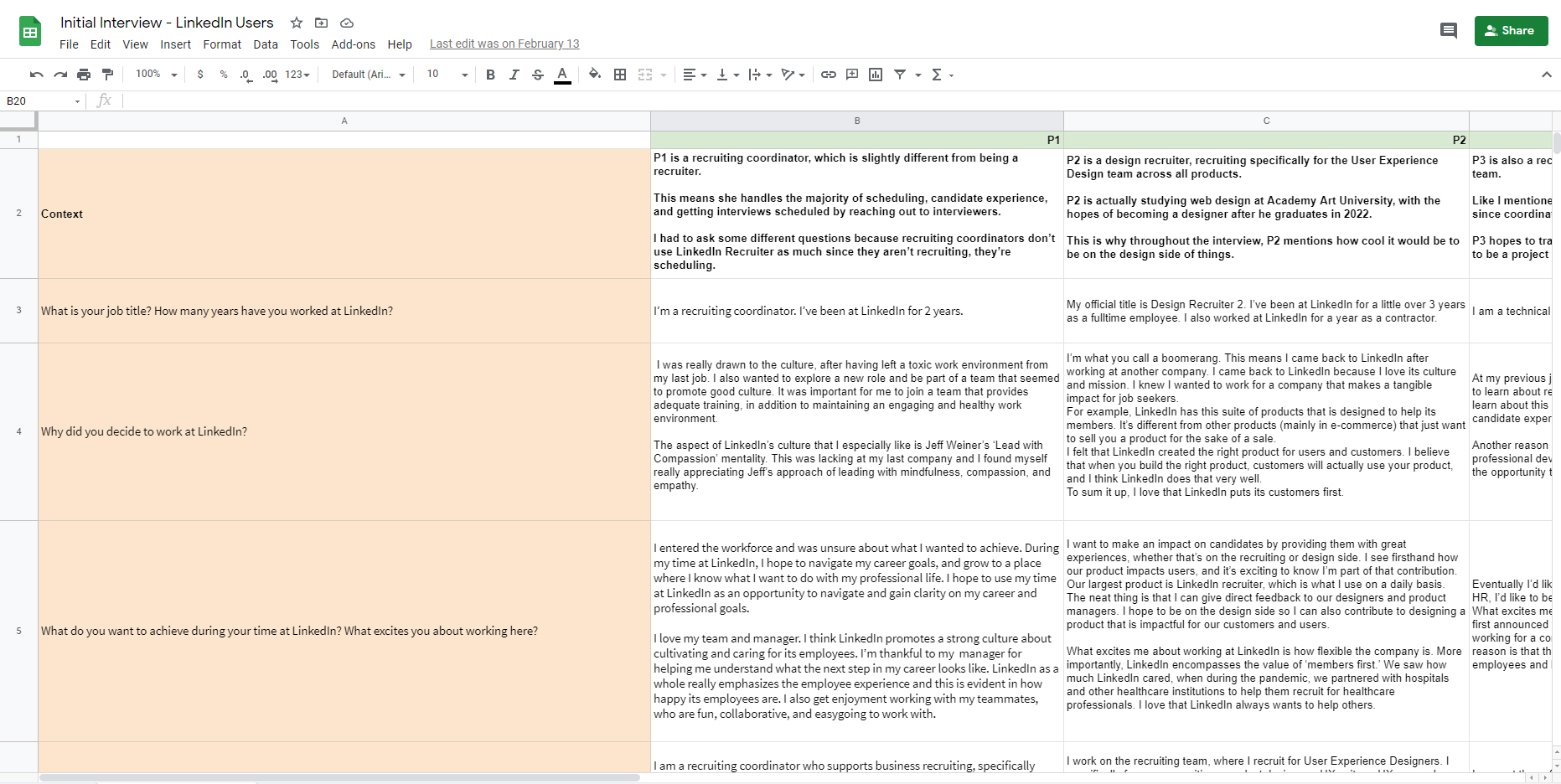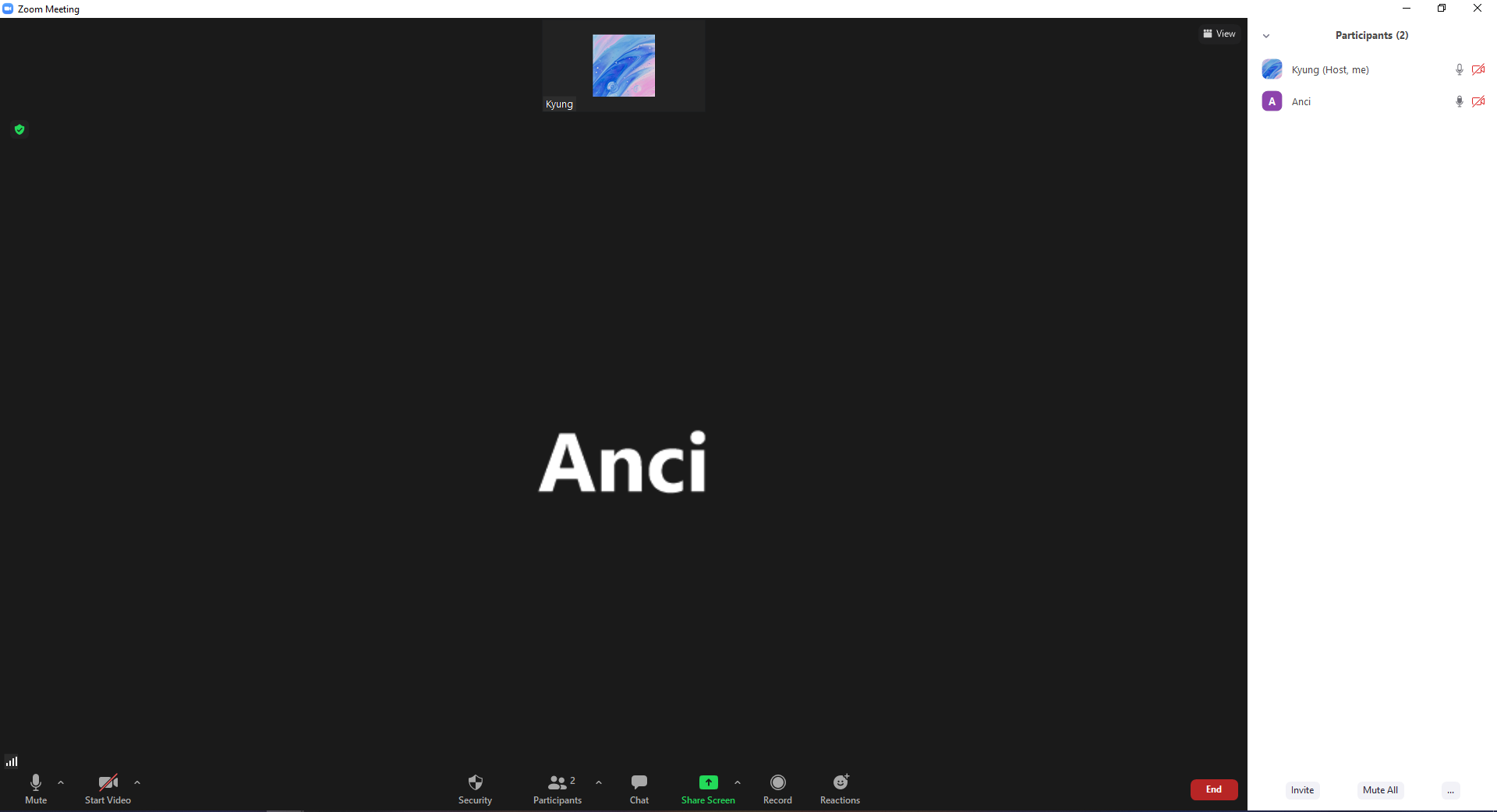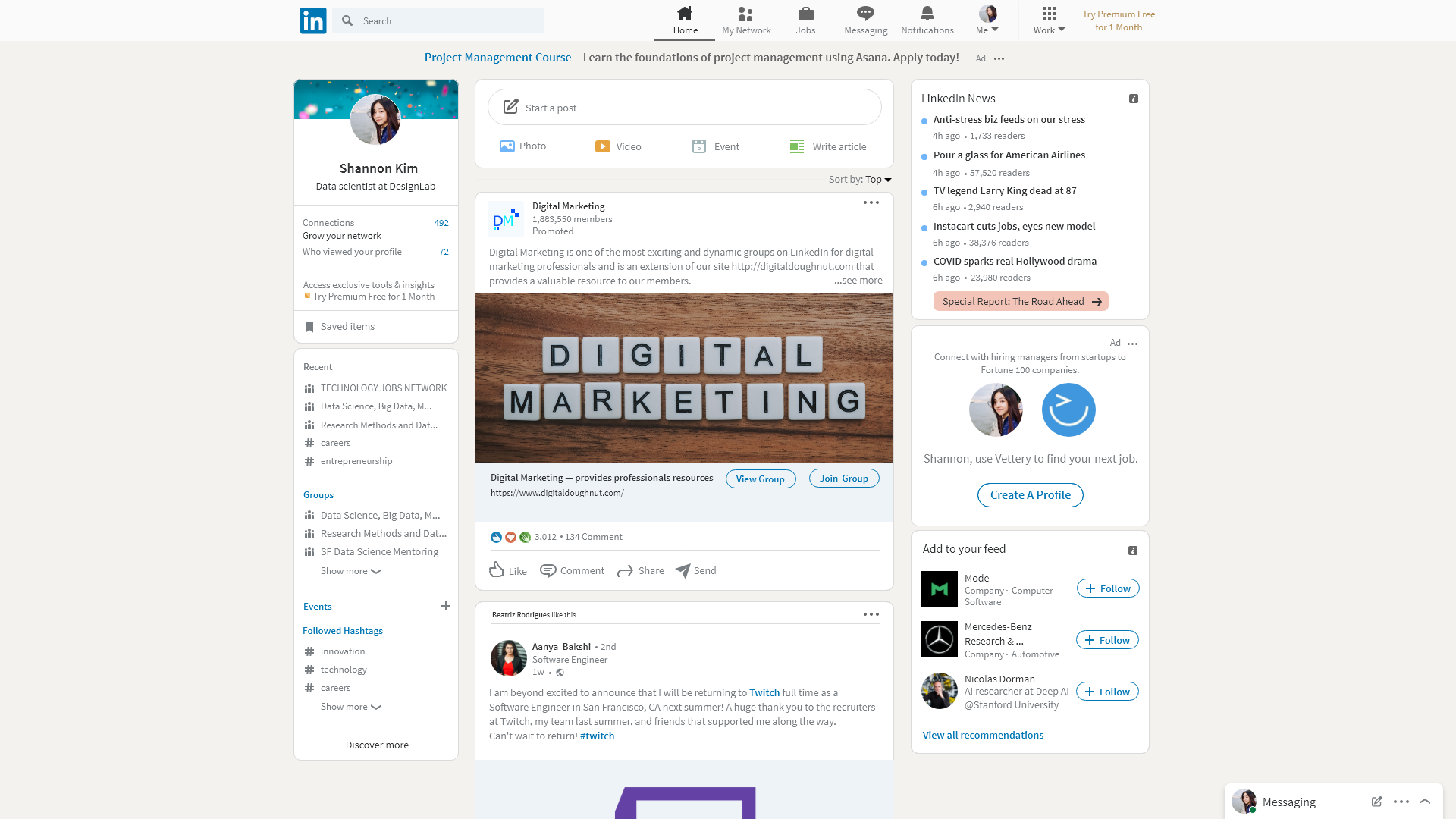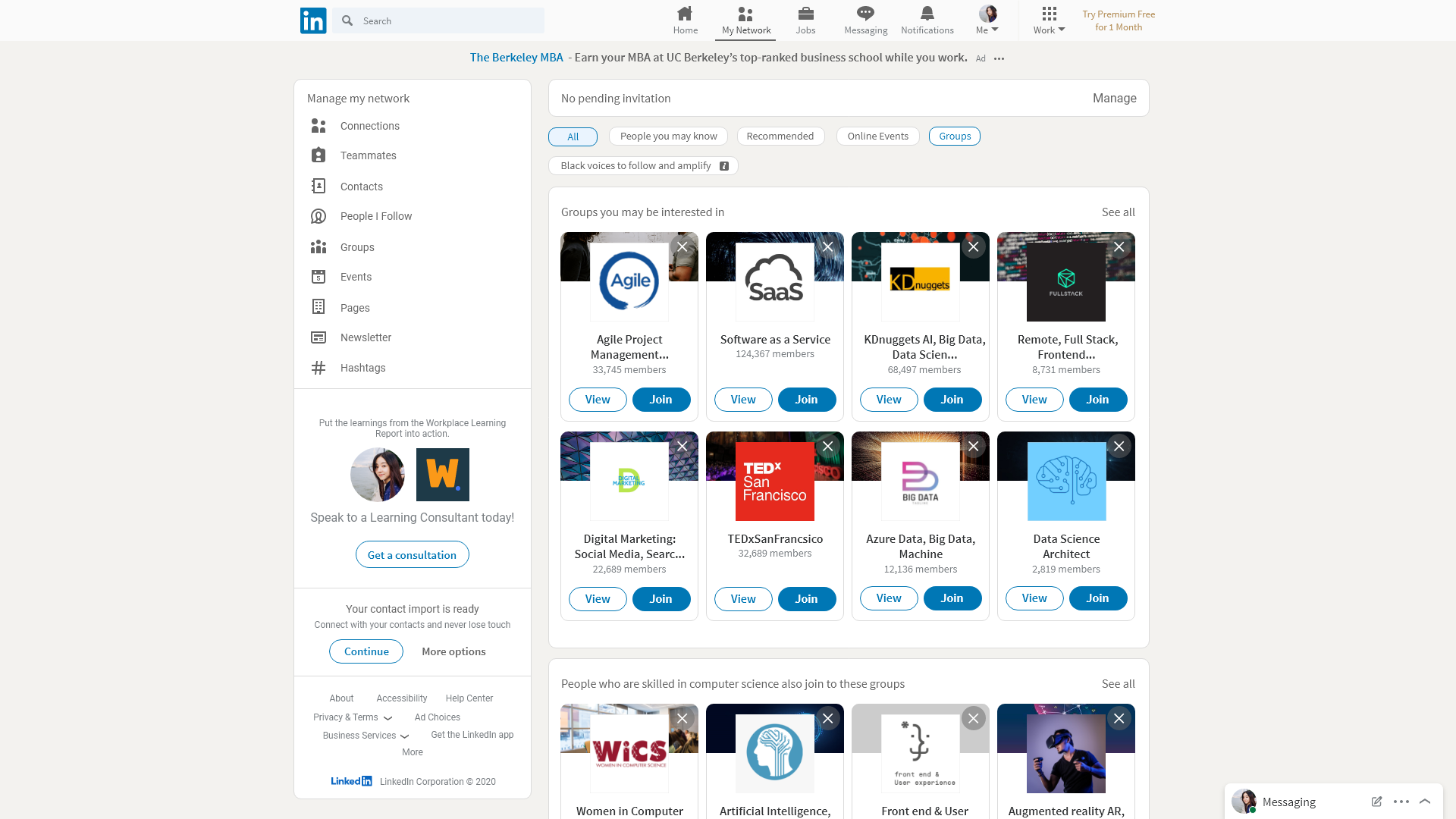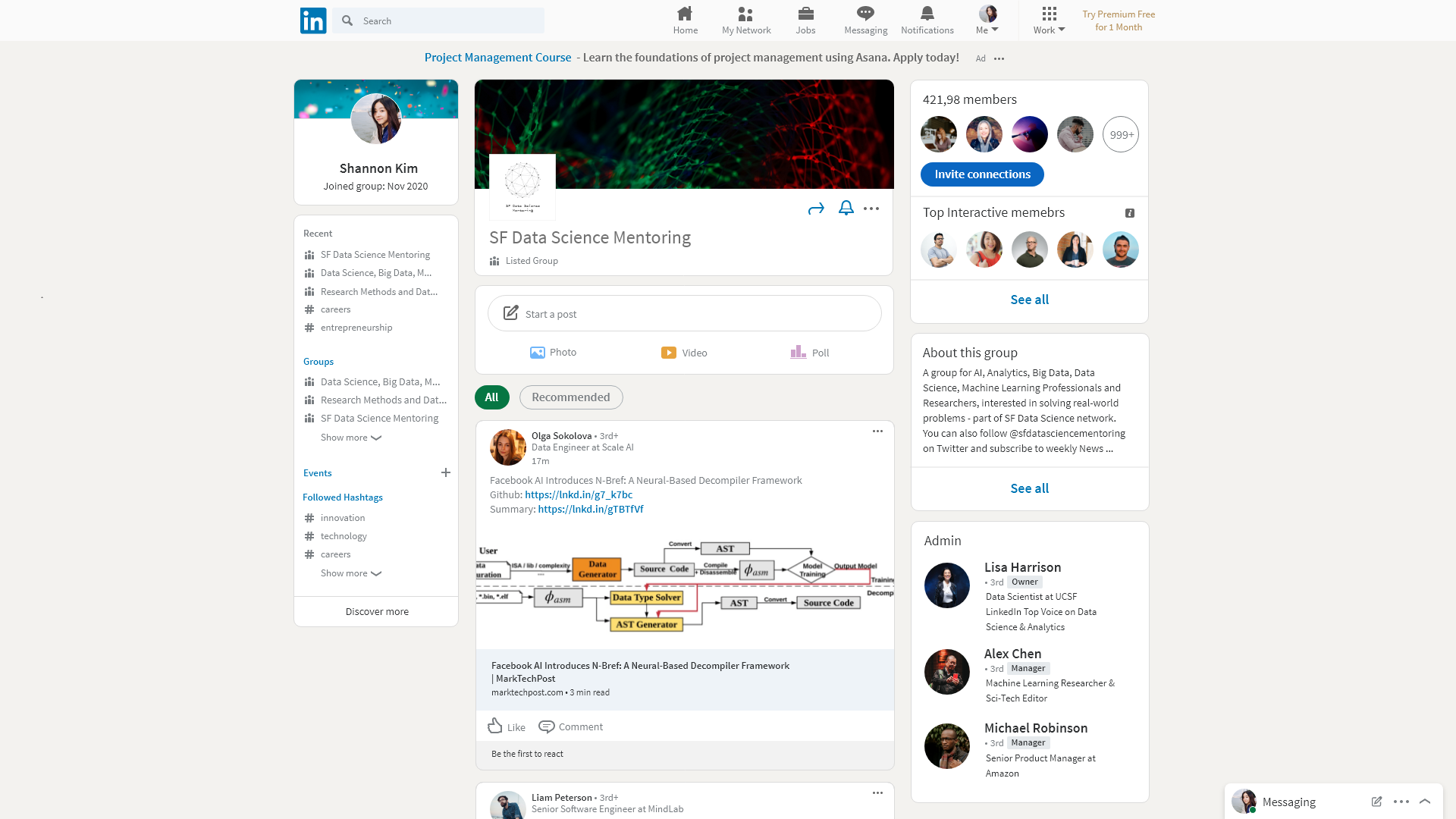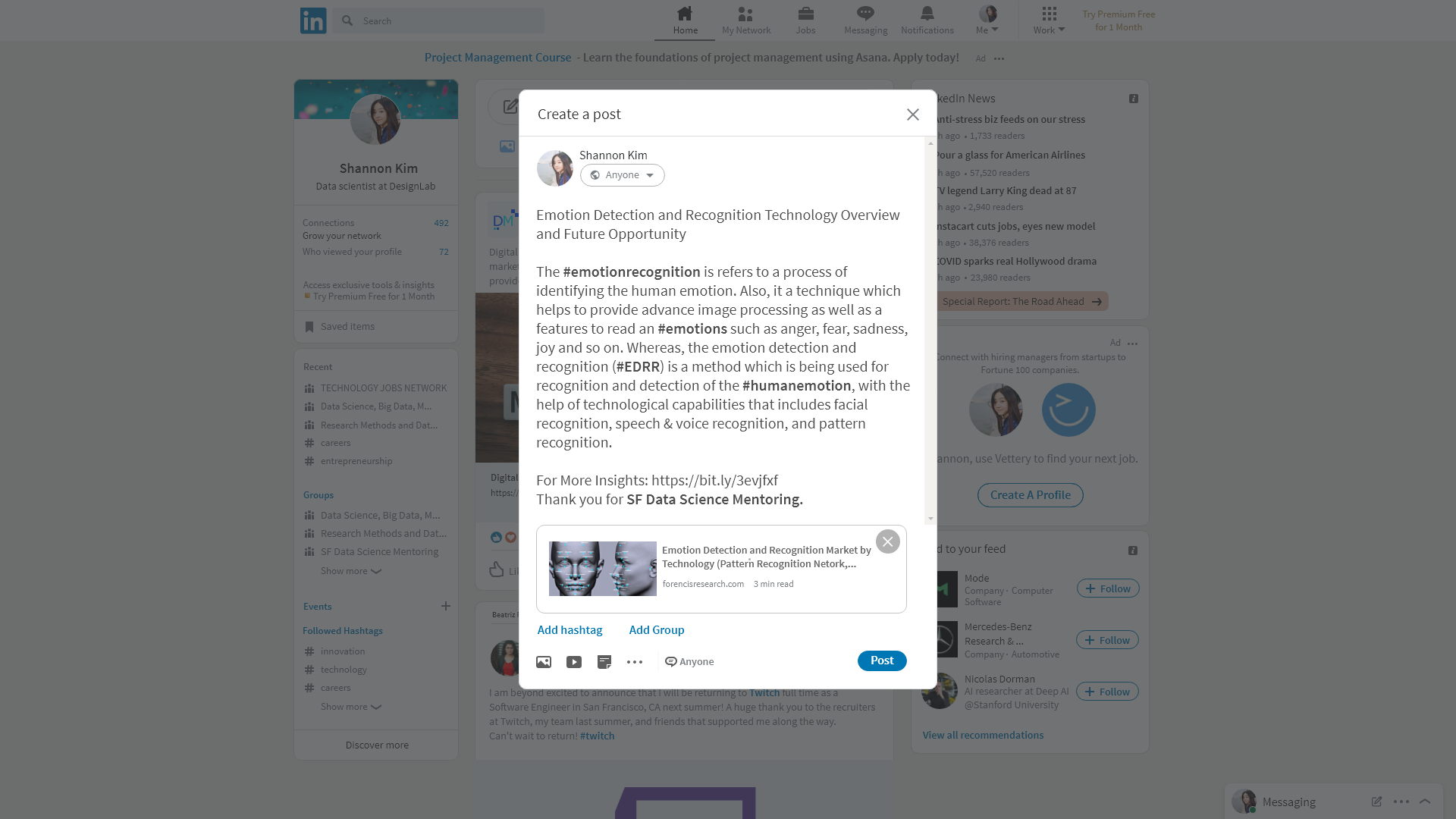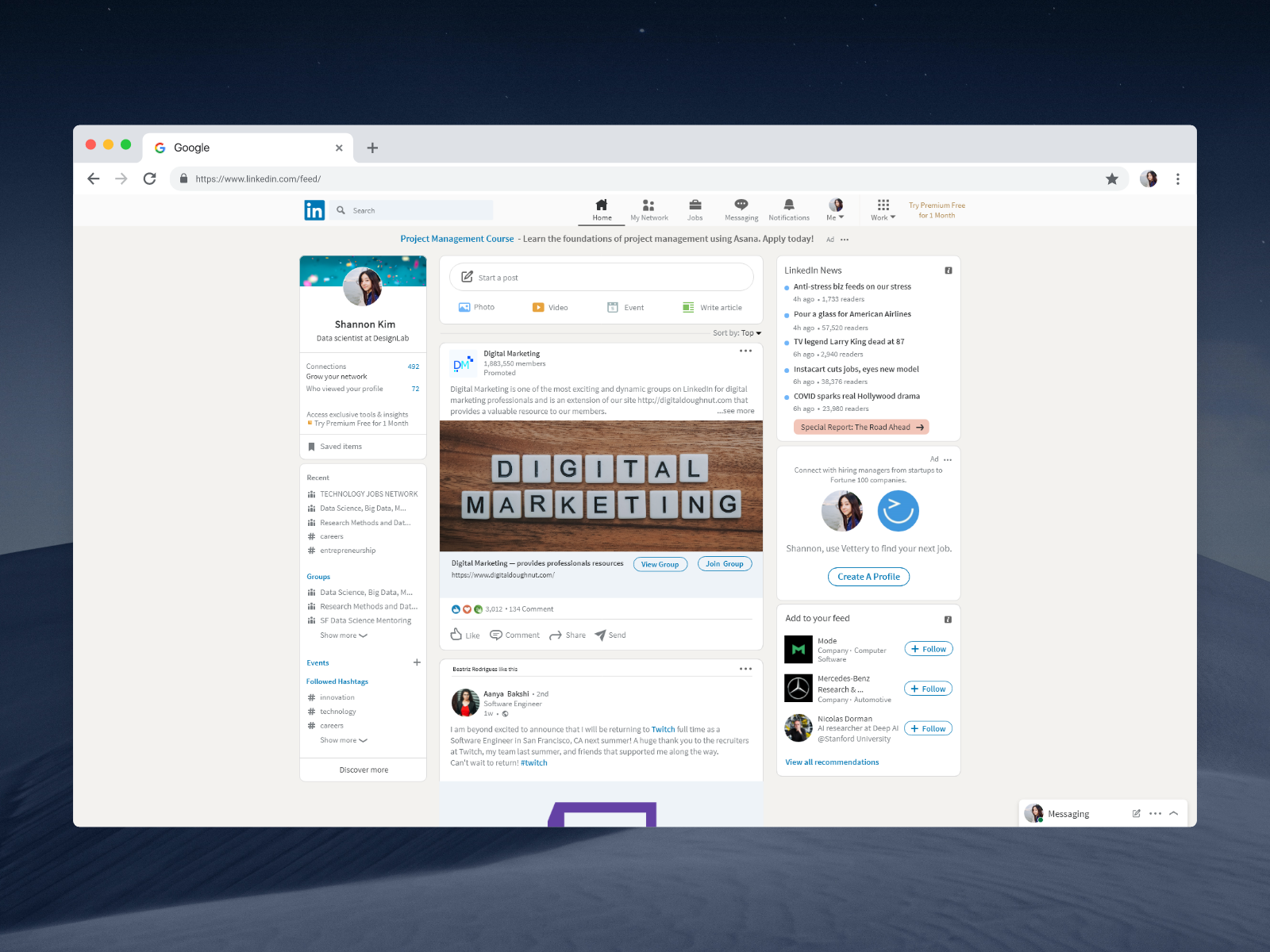
LinkedIn Case Study
LinkedIn Case Study
TEAM
Anci Sun
MENTORS
Catherine Tran
MY CONTRIBUTIONS
Design Research
User Experience Design
Rapid Prototyping
DURATION
8 Weeks
TEAM
Anci Sun
MENTORS
Catherine Tran
MY CONTRIBUTIONS
Design Research
User Experience Design
Rapid Prototyping
DURATION
8 Weeks
TEAM
Anci Sun
MENTORS
Catherine Tran
MY CONTRIBUTIONS
Design Research
User Experience Design
Rapid Prototyping
DURATION
8 Weeks
LinkedIn is a unique social and professional networking platform that helps individuals look for new opportunities and connect with other professionals.
Our desire to reshape the relationship between LinkedIn Groups and the newsfeed was born out of our interactions using the platform as job seekers during the COVID-19 pandemic. We sought to understand how LinkedIn used its unique position as a professional networking and social service to drive engagement, build community, and ultimately — help job seekers land their next role.
LinkedIn is a unique social and professional networking platform that helps individuals look for new opportunities and connect with other professionals.
Our desire to reshape the relationship between LinkedIn Groups and the newsfeed was born out of our interactions using the platform as job seekers during the COVID-19 pandemic. We sought to understand how LinkedIn used its unique position as a professional networking and social service to drive engagement, build community, and ultimately — help job seekers land their next role.
LinkedIn is a unique social and professional networking platform that helps individuals look for new opportunities and connect with other professionals.
Our desire to reshape the relationship between LinkedIn Groups and the newsfeed was born out of our interactions using the platform as job seekers during the COVID-19 pandemic. We sought to understand how LinkedIn used its unique position as a professional networking and social service to drive engagement, build community, and ultimately — help job seekers land their next role.
PROBLEM STATEMENTS
INTERVIEWS
How might we incorporate interactive content to develop a meaningful relationship between LinkedIn Groups and the newsfeed?
After these interviews, we discovered patterns in how candidates, job seekers, and employers described their experiences with LinkedIn. Based on these insights, we generated HMW (How Might We) questions that we then grouped under the following categories:
- Engagement
- Connection
- Customization
- Information
- Job Search
- Motivation
- Organization
After these interviews, we discovered patterns in how candidates, job seekers, and employers described their experiences with LinkedIn. Based on these insights, we generated HMW (How Might We) questions that we then grouped under the following categories:
- Engagement
- Connection
- Customization
- Information
- Job Search
- Motivation
- Organization
How can we encourage individuals to connect, engage, and meet with other like-minded professionals using LinkedIn Groups?
After these interviews, we discovered patterns in how candidates, job seekers, and employers described their experiences with LinkedIn. Based on these insights, we generated HMW (How Might We) questions that we then grouped under the following categories:
- Engagement
- Connection
- Customization
- Information
- Job Search
- Motivation
- Organization
After these interviews, we discovered patterns in how candidates, job seekers, and employers described their experiences with LinkedIn. Based on these insights, we generated HMW (How Might We) questions that we then grouped under the following categories:
- Engagement
- Connection
- Customization
- Information
- Job Search
- Motivation
- Organization
Research
Research
INTERVIEWS
INTERVIEWS
We conducted interviews with various groups, such as members of the LinkedIn recruiting team, students, and job seekers to better understand their unique experiences and interactions with the platform. These unique perspectives helped us develop our research statement around how LinkedIn uses interaction to engage its diverse community of users.
We conducted interviews with various groups, such as members of the LinkedIn recruiting team, students, and job seekers to better understand their unique experiences and interactions with the platform. These unique perspectives helped us develop our research statement around how LinkedIn uses interaction to engage its diverse community of users.
We conducted interviews with various groups, such as members of the LinkedIn recruiting team, students, and job seekers to better understand their unique experiences and interactions with the platform. These unique perspectives helped us develop our research statement around how LinkedIn uses interaction to engage its diverse community of users.
Linkedin Recruting Team
“I knew I wanted to work for a company that makes a tangible impact for job seekers and I found that in LinkedIn. LinkedIn is different from other products in that it provides a suite of products designed to help its members. Looking to find the right candidates? We have a solution for that. Need to build your employer brand? We have that covered.” – M.G. –
“One of LinkedIn’s strengths is that it’s so much more than a networking site. Although it’s great seeing updates from former coworkers or acquaintances on my newsfeed, I love that I can easily stay connected with a myriad of people on a personal level.” – K.W. –
Linkedin Recruting Team
“I knew I wanted to work for a company that makes a tangible impact for job seekers and I found that in LinkedIn. LinkedIn is different from other products in that it provides a suite of products designed to help its members. Looking to find the right candidates? We have a solution for that. Need to build your employer brand? We have that covered.” – M.G. –
“One of LinkedIn’s strengths is that it’s so much more than a networking site. Although it’s great seeing updates from former coworkers or acquaintances on my newsfeed, I love that I can easily stay connected with a myriad of people on a personal level.” – K.W. –
Linkedin Recruting Team
“I knew I wanted to work for a company that makes a tangible impact for job seekers and I found that in LinkedIn. LinkedIn is different from other products in that it provides a suite of products designed to help its members. Looking to find the right candidates? We have a solution for that. Need to build your employer brand? We have that covered.” – M.G. –
“One of LinkedIn’s strengths is that it’s so much more than a networking site. Although it’s great seeing updates from former coworkers or acquaintances on my newsfeed, I love that I can easily stay connected with a myriad of people on a personal level.” – K.W. –
Students
“I’m a junior in college. One of the clubs that I’m involved in encouraged me to create a LinkedIn profile to start networking. I don’t really know how to connect with people outside of my professors and classmates.” – S.M. –
“I recently learned that LinkedIn utilizes an algorithm for posts. I’m going to be more mindful of creating relevant posts that help me reach the right audience for professional advice.” – Y.C. –
“It can be a little intimidating being on LinkedIn because the posts on my newsfeed are all from senior professionals. I would feel better seeing posts from people who are also in college, or who just graduated.” – E.N –
Students
“I’m a junior in college. One of the clubs that I’m involved in encouraged me to create a LinkedIn profile to start networking. I don’t really know how to connect with people outside of my professors and classmates.” – S.M. –
“I recently learned that LinkedIn utilizes an algorithm for posts. I’m going to be more mindful of creating relevant posts that help me reach the right audience for professional advice.” – Y.C. –
“It can be a little intimidating being on LinkedIn because the posts on my newsfeed are all from senior professionals. I would feel better seeing posts from people who are also in college, or who just graduated.” – E.N –
Job Seekers
“One of the features that I like about LinkedIn is that some job postings state the hiring manager or recruiter so you can reach out and connect with them.” – N.K. –
“I started joining LinkedIn groups when the pandemic started to get to know other sales professionals but found that most of the time, the groups were pretty quiet with the exception of the occasional promotional post.” – J.C. –
“The job-seeking process is always tedious, but I like that sometimes you can apply from LinkedIn directly. This helps me follow the progress of my application so that I know if my resume was received by a recruiter.” – N.P. –
Job Seekers
“One of the features that I like about LinkedIn is that some job postings state the hiring manager or recruiter so you can reach out and connect with them.” – N.K. –
“I started joining LinkedIn groups when the pandemic started to get to know other sales professionals but found that most of the time, the groups were pretty quiet with the exception of the occasional promotional post.” – J.C. –
“The job-seeking process is always tedious, but I like that sometimes you can apply from LinkedIn directly. This helps me follow the progress of my application so that I know if my resume was received by a recruiter.” – N.P. –
Job Seekers
“One of the features that I like about LinkedIn is that some job postings state the hiring manager or recruiter so you can reach out and connect with them.” – N.K. –
“I started joining LinkedIn groups when the pandemic started to get to know other sales professionals but found that most of the time, the groups were pretty quiet with the exception of the occasional promotional post.” – J.C. –
“The job-seeking process is always tedious, but I like that sometimes you can apply from LinkedIn directly. This helps me follow the progress of my application so that I know if my resume was received by a recruiter.” – N.P. –
SECONDARY RESEARCH
In our secondary research, we learned about the LinkedIn feed system and how it generated engagement between 1st and 3rd connections. We also learned more about the advantages and disadvantages of using LinkedIn Groups.
In our secondary research, we learned about the LinkedIn feed system and how it generated engagement between 1st and 3rd connections. We also learned more about the advantages and disadvantages of using LinkedIn Groups.
In our secondary research, we learned about the LinkedIn feed system and how it generated engagement between 1st and 3rd connections. We also learned more about the advantages and disadvantages of using LinkedIn Groups.
In our secondary research, we learned about the LinkedIn feed system and how it generated engagement between 1st and 3rd connections. We also learned more about the advantages and disadvantages of using LinkedIn Groups.

“Groups used to be a very popular way to use Linkedin, but now they’re difficult to navigate to, and posts rarely show up in feeds.”
– WNIP –
“This allows you to illustrate your expertise in a subject and start growing relationships with like-minded people that could also benefit from being part of your group.” – Forbes –
“LinkedIn groups can be a great way to build your credibility in the IoT community, find influencers, engage with practitioners and reach prospects.” – Merritt GROUP –
“Groups used to be a very popular way to use Linkedin, but now they’re difficult to navigate to, and posts rarely show up in feeds.”
– WNIP –
“This allows you to illustrate your expertise in a subject and start growing relationships with like-minded people that could also benefit from being part of your group.” – Forbes –
“LinkedIn groups can be a great way to build your credibility in the IoT community, find influencers, engage with practitioners and reach prospects.” – Merritt GROUP –
“Groups used to be a very popular way to use Linkedin, but now they’re difficult to navigate to, and posts rarely show up in feeds.”
– WNIP –
“This allows you to illustrate your expertise in a subject and start growing relationships with like-minded people that could also benefit from being part of your group.”
– Forbes –
“LinkedIn groups can be a great way to build your credibility in the IoT community, find influencers, engage with practitioners and reach prospects.”
– Merritt GROUP –
“Groups used to be a very popular way to use Linkedin, but now they’re difficult to navigate to, and posts rarely show up in feeds.”
– WNIP –
“This allows you to illustrate your expertise in a subject and start growing relationships with like-minded people that could also benefit from being part of your group.” – Forbes –
“LinkedIn groups can be a great way to build your credibility in the IoT community, find influencers, engage with practitioners and reach prospects.” – Merritt GROUP –
INSIGHTS
INSIGHTS
1. Asking for advice or help via a post on the newsfeed requires a certain number of connections because more exposure increases the visibility of one’s post.
After these interviews, we discovered patterns in how candidates, job seekers, and employers described their experiences with LinkedIn. Based on these insights, we generated HMW (How Might We) questions that we then grouped under the following categories:
- Engagement
- Connection
- Customization
- Information
- Job Search
- Motivation
- Organization
After these interviews, we discovered patterns in how candidates, job seekers, and employers described their experiences with LinkedIn. Based on these insights, we generated HMW (How Might We) questions that we then grouped under the following categories:
- Engagement
- Connection
- Customization
- Information
- Job Search
- Motivation
- Organization
2. The quality of one’s connections isn’t determined by the quantity of connections. Good quality connections require finding the right people to connect with, whether that’s via messaging or commenting.
After these interviews, we discovered patterns in how candidates, job seekers, and employers described their experiences with LinkedIn. Based on these insights, we generated HMW (How Might We) questions that we then grouped under the following categories:
- Engagement
- Connection
- Customization
- Information
- Job Search
- Motivation
- Organization
After these interviews, we discovered patterns in how candidates, job seekers, and employers described their experiences with LinkedIn. Based on these insights, we generated HMW (How Might We) questions that we then grouped under the following categories:
- Engagement
- Connection
- Customization
- Information
- Job Search
- Motivation
- Organization
3. Many users do not know how the LinkedIn algorithm works.
After these interviews, we discovered patterns in how candidates, job seekers, and employers described their experiences with LinkedIn. Based on these insights, we generated HMW (How Might We) questions that we then grouped under the following categories:
- Engagement
- Connection
- Customization
- Information
- Job Search
- Motivation
- Organization
After these interviews, we discovered patterns in how candidates, job seekers, and employers described their experiences with LinkedIn. Based on these insights, we generated HMW (How Might We) questions that we then grouped under the following categories:
- Engagement
- Connection
- Customization
- Information
- Job Search
- Motivation
- Organization
4. Many LinkedIn users are satisfied or content at their current jobs, they are considered “passive” users who treat LinkedIn as another social media platform.
After these interviews, we discovered patterns in how candidates, job seekers, and employers described their experiences with LinkedIn. Based on these insights, we generated HMW (How Might We) questions that we then grouped under the following categories:
- Engagement
- Connection
- Customization
- Information
- Job Search
- Motivation
- Organization
After these interviews, we discovered patterns in how candidates, job seekers, and employers described their experiences with LinkedIn. Based on these insights, we generated HMW (How Might We) questions that we then grouped under the following categories:
- Engagement
- Connection
- Customization
- Information
- Job Search
- Motivation
- Organization
5. Ultimately, it is important to connect with others in person as opposed to online. Online connections can easily end up being superficial.
After these interviews, we discovered patterns in how candidates, job seekers, and employers described their experiences with LinkedIn. Based on these insights, we generated HMW (How Might We) questions that we then grouped under the following categories:
- Engagement
- Connection
- Customization
- Information
- Job Search
- Motivation
- Organization
After these interviews, we discovered patterns in how candidates, job seekers, and employers described their experiences with LinkedIn. Based on these insights, we generated HMW (How Might We) questions that we then grouped under the following categories:
- Engagement
- Connection
- Customization
- Information
- Job Search
- Motivation
- Organization
FRAMING
FRAMING
After these interviews, we discovered patterns in how candidates, job seekers, and employers described their experiences with LinkedIn. Based on these insights, we generated HMW (How Might We) questions that we then grouped under the following categories:
- Engagement
- Connection
- Customization
- Information
- Job Search
- Motivation
- Organization
After these interviews, we discovered patterns in how candidates, job seekers, and employers described their experiences with LinkedIn. Based on these insights, we generated HMW (How Might We) questions that we then grouped under the following categories:
- Engagement
- Connection
- Customization
- Information
- Job Search
- Motivation
- Organization
After these interviews, we discovered patterns in how candidates, job seekers, and employers described their experiences with LinkedIn. Based on these insights, we generated HMW (How Might We) questions that we then grouped under the following categories:
- Engagement
- Connection
- Customization
- Information
- Job Search
- Motivation
- Organization
HYPOTHETICAL USER MODEL
HYPOTHETICAL USER MODEL
Based on our research, we created a hypothetical user model (Shannon), who is a data scientist at Startup. Shannon has been thinking of leaving her current job and has started passively looking for other data science roles. She’s always been a passive user but has started data science groups to start reaching out to other data science professionals. She hopes that joining these groups and engaging with other users will help her find her next opportunity.
Based on our research, we created a hypothetical user model (Shannon), who is a data scientist at Startup. Shannon has been thinking of leaving her current job and has started passively looking for other data science roles. She’s always been a passive user but has started data science groups to start reaching out to other data science professionals. She hopes that joining these groups and engaging with other users will help her find her next opportunity.
Based on our research, we created a hypothetical user model (Shannon), who is a data scientist at Startup. Shannon has been thinking of leaving her current job and has started passively looking for other data science roles. She’s always been a passive user but has started data science groups to start reaching out to other data science professionals. She hopes that joining these groups and engaging with other users will help her find her next opportunity.
Ideation
Ideation
DESIGN EXPLORATIONS
DESIGN EXPLORATIONS
We gathered the insights from our researches to conceptualize the following initial ideas.
- Expanding the groups container on the newsfeed.
- Adding filters to the recommendations tab.
- Allowing users to tag groups when creating posts.
- Promoting groups of interest on the newsfeed.
- Showing top interactive users in groups.
- Adding more filters to the followers section.
We gathered the insights from our researches to conceptualize the following initial ideas.
- Expanding the groups container on the newsfeed.
- Adding filters to the recommendations tab.
- Allowing users to tag groups when creating posts.
- Promoting groups of interest on the newsfeed.
- Showing top interactive users in groups.
- Adding more filters to the followers section.
We gathered the insights from our researches to conceptualize the following initial ideas.
- Expanding the groups container on the newsfeed.
- Adding filters to the recommendations tab.
- Allowing users to tag groups when creating posts.
- Promoting groups of interest on the newsfeed.
- Showing top interactive users in groups.
- Adding more filters to the followers section.
WIREFRAMES
PROBLEMS
We added and removed concepts from the initial ideas to work toward delivering a straightforward and interactive experience between LinkedIn Groups and the newsfeed. We moved our work into Adobe XD to explore the following concepts in more detail.
We added and removed concepts from the initial ideas to work toward delivering a straightforward and interactive experience between LinkedIn Groups and the newsfeed. We moved our work into Adobe XD to explore the following concepts in more detail.
We added and removed concepts from the initial ideas to work toward delivering a straightforward and interactive experience between LinkedIn Groups and the newsfeed. We moved our work into Adobe XD to explore the following concepts in more detail.
Refinement
Refinement
SOLUTIONS
Promoting groups of interest on the newsfeed.
Users can see the groups that may be interested to view or join the groups on the newsfeed. Promoted groups potentially create new members for meaningful and active engagement.
Promoting groups of interest on the newsfeed.
Users can see the groups that may be interested to view or join the groups on the newsfeed. Promoted groups potentially create new members for meaningful and active engagement.
Promoting groups of interest on the newsfeed.
Users can see the groups that may be interested to view or join the groups on the newsfeed. Promoted groups potentially create new members for meaningful and active engagement.
View recommended groups based on your profile and preferences.
This feature allows users to view recommended groups based on their interests, in addition to helping them discover groups with like-minded professionals.
View recommended groups based on your profile and preferences.
This feature allows users to view recommended groups based on their interests, in addition to helping them discover groups with like-minded professionals.
View recommended groups based on your profile and preferences.
This feature allows users to view recommended groups based on their interests, in addition to helping them discover groups with like-minded professionals.
Display the top interactive members in groups.
This capability allows users to see the top contributors in the groups they’re part of. Making this capability visible will encourage new and existing users to participate, connect, and engage with other members.
Display the top interactive members in groups.
This capability allows users to see the top contributors in the groups they’re part of. Making this capability visible will encourage new and existing users to participate, connect, and engage with other members.
Display the top interactive members in groups.
This capability allows users to see the top contributors in the groups they’re part of. Making this capability visible will encourage new and existing users to participate, connect, and engage with other members.
Display the top interactive members in groups.
This capability allows users to see the top contributors in the groups they’re part of. Making this capability visible will encourage new and existing users to participate, connect, and engage with other members.
Tag groups when creating posts for the newsfeed
Users can tag groups when creating posts. This allows users to select which groups their posts would appear in.
Tag groups when creating posts for the newsfeed
Users can tag groups when creating posts. This allows users to select which groups their posts would appear in.
Tag groups when creating posts for the newsfeed
Users can tag groups when creating posts. This allows users to select which groups their posts would appear in.
Tag groups when creating posts for the newsfeed
Users can tag groups when creating posts. This allows users to select which groups their posts would appear in.
Conclusion
Conclusion
REFLECTION
PROBLEMS
It was 8 years ago I first heard about LinkedIn and, out of curiosity, decided to create a profile. I still remember how challenging it was to perform tasks such as adding profile information or sending connection requests due to a language barrier. Today, LinkedIn has made improvements to address the language barrier concern by introducing an audio recording feature to share how to pronounce one’s name or using visuals to indicate when a company is hiring. These improvements and many other factors have helped LinkedIn gain an irreplaceable position in the professional network world.
My teammate (a former LinkedIn HR employee) and I wanted to explore social behaviors that arose from working virtually during the COVID-19 pandemic. We spoke with LinkedIn employees on the recruiting team and individual users to learn from their perspectives. Our biggest challenge was leveraging user feedback to understand how to build features driven by this new definition of engagement. These conversations helped us discover how engagement changed due to doing everything in a virtual environment.
It was 8 years ago when I first heard about LinkedIn and out of curiosity, decided to create a profile. I still remember how challenging it was to perform tasks such as adding profile information or sending connection requests due to a language barrier. Today, LinkedIn has made improvements to address the language barrier concern, by introducing an audio recording feature to share how to pronounce one’s name, or using visuals to indicate when a company is hiring. These improvements, along with many other factors, have helped LinkedIn gain an irreplaceable position in the professional network world.
My teammate (a former LinkedIn HR employee) and I wanted to explore social behaviors that arose as a result of working virtually during the COVID-19 pandemic. We spoke with LinkedIn employees on the recruiting team, as well as individual users to learn from their perspectives. These conversations helped us discover how engagement changed as a result of doing everything in a virtual environment. Our biggest challenge was leveraging user feedback to understand how to build features that were driven by this new definition of engagement.
It was 8 years ago when I first heard about LinkedIn and out of curiosity, decided to create a profile. I still remember how challenging it was to perform tasks such as adding profile information or sending connection requests due to a language barrier. Today, LinkedIn has made improvements to address the language barrier concern, by introducing an audio recording feature to share how to pronounce one’s name, or using visuals to indicate when a company is hiring. These improvements, along with many other factors, have helped LinkedIn gain an irreplaceable position in the professional network world.
My teammate (a former LinkedIn HR employee) and I wanted to explore social behaviors that arose as a result of working virtually during the COVID-19 pandemic. We spoke with LinkedIn employees on the recruiting team, as well as individual users to learn from their perspectives. These
conversations helped us discover how engagement changed as a result of doing everything in a virtual environment. Our biggest challenge was leveraging user feedback to understand how to build features that were driven by this new definition of engagement.
It was 8 years ago when I first heard about LinkedIn and out of curiosity, decided to create a profile. I still remember how challenging it was to perform tasks such as adding profile information or sending connection requests due to a language barrier. Today, LinkedIn has made improvements to address the language barrier concern, by introducing an audio recording feature to share how to pronounce one’s name, or using visuals to indicate when a company is hiring. These improvements, along with many other factors, have helped LinkedIn gain an irreplaceable position in the professional network world.
My teammate (a former LinkedIn HR employee) and I wanted to explore social behaviors that arose as a result of working virtually during the COVID-19 pandemic. We spoke with LinkedIn employees on the recruiting team, as well as individual users to learn from their perspectives. These
conversations helped us discover how engagement changed as a result of doing everything in a virtual environment. Our biggest challenge was leveraging user feedback to understand how to build features that were driven by this new definition of engagement.
